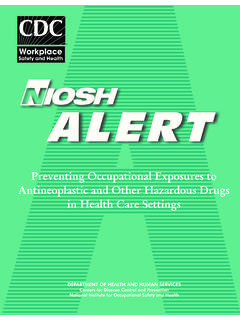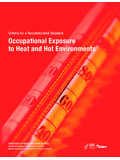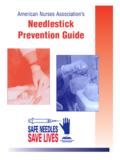Transcription of Fentanyl Exposure, Protection, and Treatment Myths …
1 Fentanyl Exposure, Protection, and Treatment Myths and Facts Information from Health Canada s Public Service occupational Health Program (Adapted from USA Dept. of Homeland Security 2017) EXPOSURE MYTH: Touching even a small amount of Fentanyl can cause opioid overdose, coma, or death. FACT: Incidental skin exposure to Fentanyl is extremely unlikely to immediately harm you. Fentanyl and other potent synthetic opioids may appear as a powder, tablet, capsule, or in solution Inhaling or transferring Fentanyl from skin to mucous membranes (eyes, nose or mouth) are the most common types of incidental exposure DO: wash the affected area with soap and water as soon as possible to easily remove Fentanyl residue DON T use alcohol-based hand sanitizers, wipes or products. They may increase absorption of Fentanyl MYTH: First responders have overdosed after contact with a Fentanyl overdose victim or contaminated environment.
2 FACT: Most first responders' encounters with overdose victims and contaminated environments do not present a significant drug exposure threat to responders. Experts agree that routine encounters to Fentanyl does not present a significant risk of drug exposure DO: ensure that all commonly used controls and protocols are followed Wear appropriate personal protective equipment (PPE), especially in unusual situations such as: High concentrations of airborne Fentanyl powder, environmental contamination, etc. There is no documented evidence of responders becoming ill after skin contact with Fentanyl PROTECTION MYTH: PPE cannot protect you from Fentanyl exposure. FACT: Worn correctly, Personal Protective Equipment will protect you. DO: wear PPE identified for the task when exposure to drug powders is likely PPE includes gloves, properly fitted respiratory protection, and safety eyewear See CSA reference below for additional information regarding PPE selection DON T use powdered gloves; powder particulates from the gloves may absorb and spread contaminants to unintended surfaces MYTH: Standard precautions for dealing with suspicious substances do not apply to Fentanyl .
3 FACT: occupational Health and Safety precautions on contact with unknown powdered substances are appropriate for most incidental encounters with Fentanyl . DO: avoid direct contact with Fentanyl if possible Wear appropriate PPE identified as required for the specific task or activity Wash your hands with soap and water often and after handling suspicious substances Soap and water is a useful control to reduce powder contamination Use proper decontamination and notification procedures for contaminated equipment or clothing DON T eat, drink or smoke after handling a suspicious substance until you have washed your hands Treatment MYTH: Naloxone can't save you from a Fentanyl overdose. FACT: Naloxone ( NARCAN Nasal Spray) is safe and counteracts the effects of an opioid overdose including Fentanyl and other synthetic opioids. DON T delay. Administer naloxone (following departmental policy and protocols), if you suspect an overdose DO: In the event of a suspected opioid overdose, call immediately for emergency medical assistance.
4 Naloxone is not a definitive medical Treatment The effects of naloxone are time limited; administer additional dose of naloxone if necessary, or if signs and symptoms reappear If naloxone is not available, provide rescue breathing or life-saving efforts until emergency services arrive MYTH: Feeling sick after encountering a powdered substance is a symptom of a Fentanyl overdose. FACT: Fentanyl overdose signs/symptoms are the same as for all opioid overdoses: slowed/shallow breathing, decreasing consciousness, pinpoint pupils. DO: administer naloxone if you suspect an overdose DON T confuse a Fentanyl overdose with the signs and symptoms of other conditions Dizziness, rapid heart rate, nausea and vomiting, or feeling ill are more specific to heat injuries, dehydration, and adrenaline responses When in doubt, administer naloxone and call for emergency medical assistance References: Consult your Departmental occupational Health & Safety policies and relevant regulations and protective guidelines.
5 Canadian Standards Association (CSA) Standard Z 11 Selection, Use and Care of Respirators. Canadian Authorized use of naloxone Nasal Spray (NARCAN) Centers for Disease Control and Prevention: NIOSH- Fentanyl : Preventing occupational Exposure to Emergency Responders. lnterAgency Board Recommendations on Selection and Use of Personal Protective Equipment and Decontamination Products for First Responders Against Exposure Hazards to Synthetic Opioids, Including Fentanyl and Fentanyl Analogues"(August 2017 )







